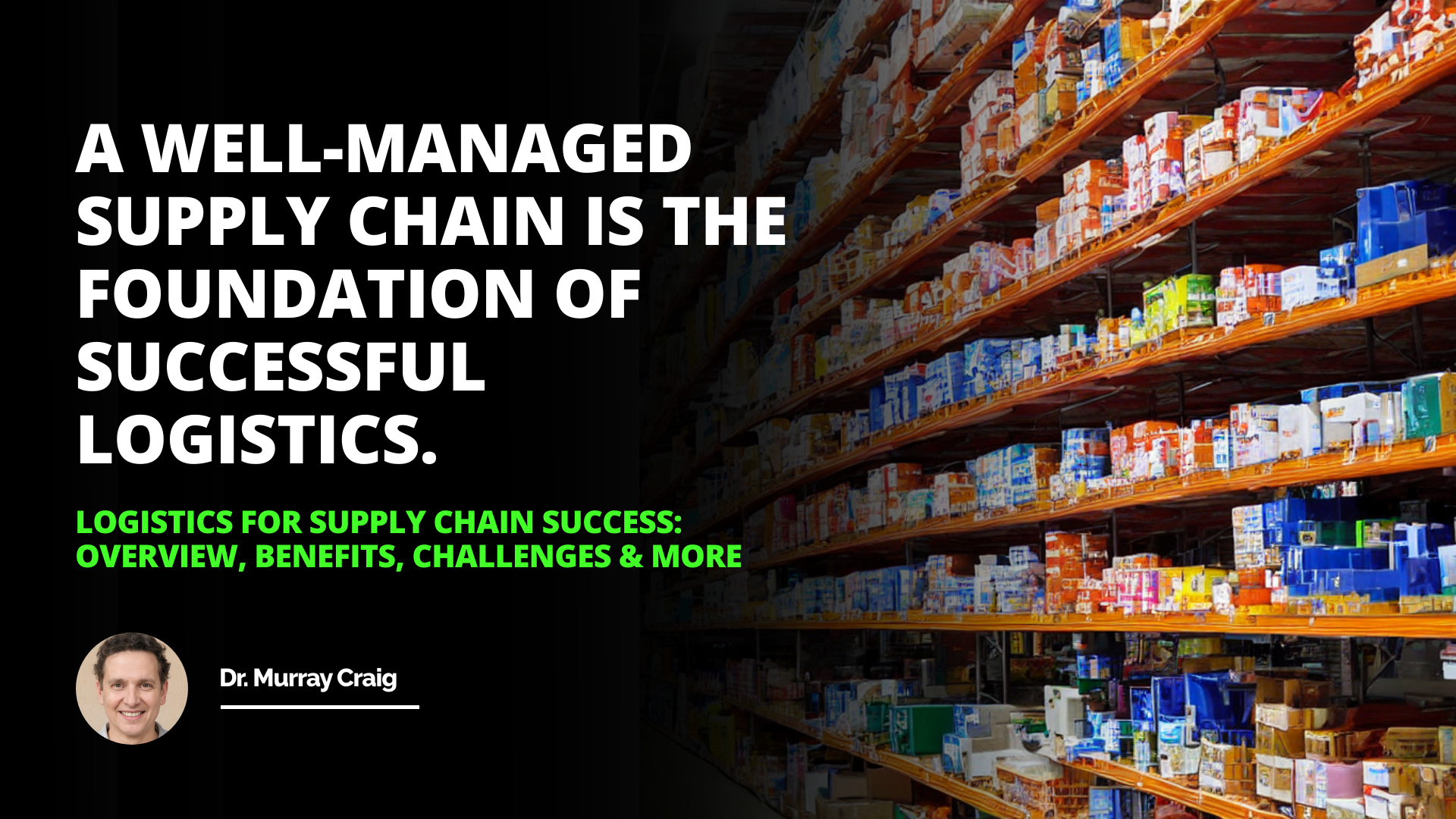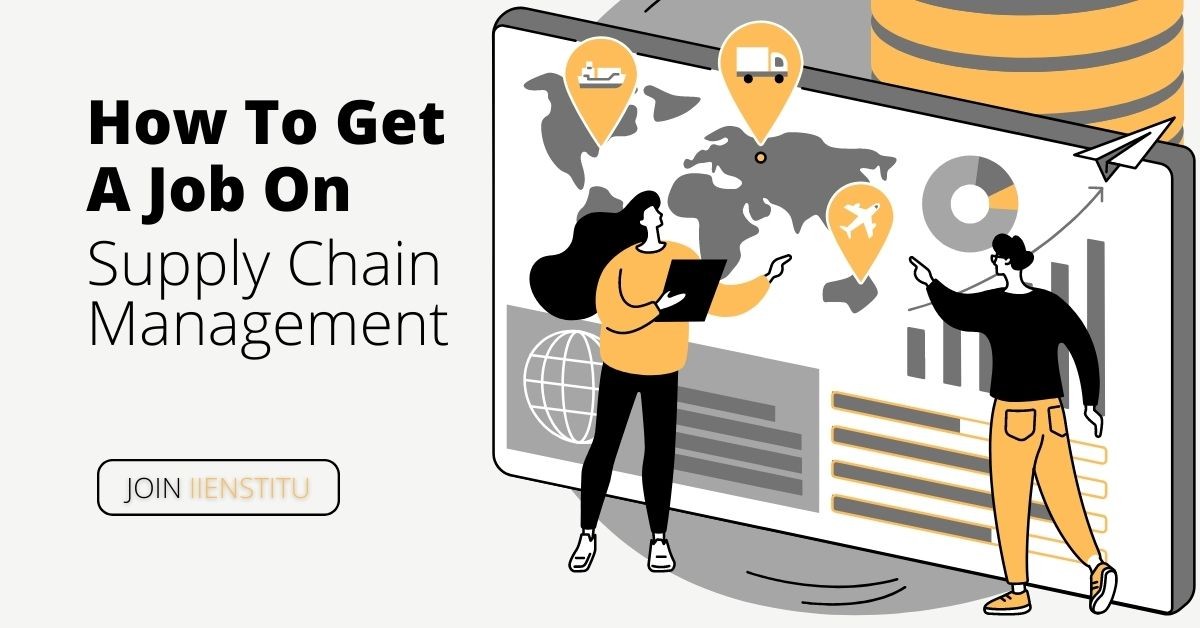
As a seasoned professional in the field of supply chain management, I have witnessed firsthand the rapid evolution and increasing complexity of this crucial aspect of business operations. In my years of experience, I have come to understand that the ability to anticipate and navigate future challenges is a key determinant of success in this dynamic industry. This is why, when interviewing candidates for roles in supply chain management, I often ask the question, "What do you believe are the future challenges in supply chain management?"
This question is not merely a conversational prompt; it serves as a litmus test for a candidate's understanding of the industry, their foresight, and their problem-solving abilities. In an ever-changing landscape shaped by technological advancements, shifting consumer preferences, and global events, the capacity to identify and strategize for future challenges is a critical skill for any supply chain professional.
The Importance of Forward-Thinking in Supply Chain Management
The field of supply chain management is not for the short-sighted. It demands a keen eye for emerging trends, a proactive approach to problem-solving, and the ability to think several steps ahead. As Peter Drucker, the renowned management consultant and author, once said, "The best way to predict the future is to create it" (Drucker, 1985, p. 89). This philosophy is particularly applicable to supply chain management.
When I pose the question about future challenges to candidates, I am not merely interested in their ability to recite a list of potential issues. Rather, I am looking for evidence of their strategic thinking capabilities. Can they not only identify possible challenges but also articulate potential solutions? Do they have a plan for how they would lead their team in navigating these challenges? These are the qualities that separate a good candidate from an exceptional one.
Interview Question: Describe a High-Stress Situation at Work
Interview Question: What Role Does Goal Setting Play in Your Time Management?
Interview Question: How Do You Balance Personal and Work Time Management?
Navigating the Complexities of Globalization
One of the most significant challenges facing supply chain management in the coming years is the increasing complexity brought about by globalization. As companies expand their operations across borders, they must contend with a myriad of logistical, cultural, and regulatory challenges. Thomas Friedman, in his book "The World is Flat," argues that globalization has "flattened" the world, creating a level playing field where businesses from all corners of the globe can compete (Friedman, 2005, p. 8). While this presents immense opportunities, it also introduces new complexities into the supply chain.
When discussing this challenge with candidates, I am looking for a nuanced understanding of the intricacies of international operations. Do they grasp the importance of cultural sensitivity in building global partnerships? Are they familiar with the various regulatory environments across different countries? Can they strategize for the logistical challenges of managing a global supply chain? A candidate who can articulate a clear strategy for navigating these complexities is one who is prepared for the future of supply chain management.
The Role of Technology in Shaping the Future of Supply Chain Management
Another key challenge that supply chain professionals must contend with is the rapid pace of technological advancement. From artificial intelligence and machine learning to blockchain and the Internet of Things, technology is revolutionizing the way we manage supply chains. As Klaus Schwab, founder of the World Economic Forum, states in his book "The Fourth Industrial Revolution," we are on the cusp of a technological revolution that will fundamentally alter the way we live, work, and relate to one another (Schwab, 2016, p. 1). For supply chain management, this means a future of unprecedented automation, data-driven decision making, and real-time visibility.
When discussing technology with candidates, I am interested in their ability to not only understand these advancements but also strategize for their implementation. How would they manage the integration of new technologies into existing supply chain processes? What strategies would they employ to ensure the security of sensitive data in an increasingly connected system? A candidate who can articulate a clear vision for leveraging technology to improve supply chain efficiency and resilience is one who is ready to lead in the industry's future.
What are the anticipated challenges in Supply Chain Management in the future?
Can you list some potential future challenges in Supply Chain Management?
What are the possible obstacles Supply Chain Management might face in the future?
What could be the hurdles in the further development of Supply Chain Management?
Are there any future challenges predicted in the field of Supply Chain Management?
What future challenges might occur in Supply Chain Management according to experts?
Could you discuss upcoming challenges that Supply Chain Management may encounter?
What is your perspective on the future challenges of Supply Chain Management?
What unforeseen changes might cause complications in future Supply Chain Management
Under current trends, what difficulties could future Supply Chain Management confront?
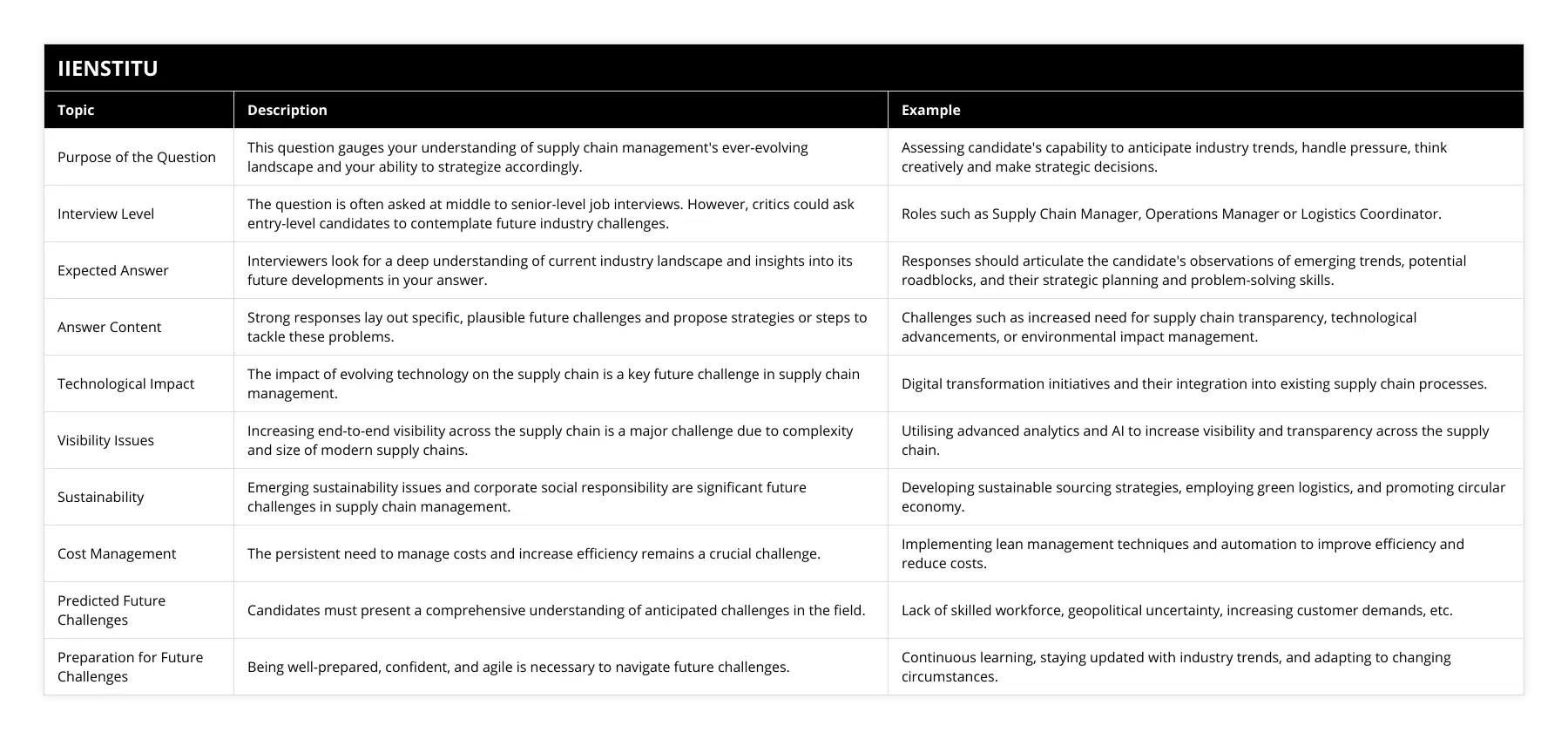
The Growing Importance of Sustainability
Sustainability has become a key consideration in supply chain management, and its importance is only set to grow in the coming years. As consumers become more environmentally and socially conscious, companies are under increasing pressure to ensure their supply chains are sustainable and ethical. John Elkington, in his book "Cannibals with Forks: The Triple Bottom Line of 21st Century Business," argues that companies must consider not just financial outcomes but also environmental and social impact (Elkington, 1997, p. 2). This triple bottom line approach is becoming increasingly central to supply chain management.
When discussing sustainability with candidates, I am looking for a comprehensive understanding of the issue. Do they grasp the environmental impact of different supply chain practices? Are they familiar with strategies for reducing waste and promoting circular economies? Can they articulate a plan for ensuring ethical labor practices throughout the supply chain? A candidate who demonstrates a commitment to sustainability and can strategize for its implementation is one who is prepared to meet the expectations of the modern consumer.
The Challenge of Risk Management
Finally, a key challenge that supply chain professionals must always be prepared for is the management of risk. From natural disasters and geopolitical events to cyber-attacks and pandemics, the supply chain is vulnerable to a wide range of disruptions. As Nassim Nicholas Taleb argues in his book "The Black Swan," it is the highly improbable and unpredictable events that often have the greatest impact (Taleb, 2007, p. xxii). For supply chain management, this means always being prepared for the unexpected.
When discussing risk management with candidates, I am interested in their strategies for building resilience into the supply chain. How would they diversify suppliers to mitigate the impact of localized disruptions? What contingency plans would they put in place for various scenarios? How would they leverage data and technology to anticipate and respond to potential threats? A candidate who demonstrates a proactive approach to risk management is one who is ready to navigate the uncertainties of the future.
"The supply chain of the future will be shaped by those who can anticipate, strategize, and adapt. It will favor the bold, the innovative, and the resilient." - A seasoned supply chain professional's insight.
Conclusion
In conclusion, the question "What do you believe are the future challenges in supply chain management?" is not a mere interview formality. It is a window into a candidate's strategic thinking, industry knowledge, and leadership potential. In a field that is constantly evolving, the ability to anticipate and navigate future challenges is a critical skill.
From the complexities of globalization to the rapid pace of technological advancement, from the growing importance of sustainability to the ever-present need for risk management, the future of supply chain management is rife with challenges. But with these challenges come immense opportunities. The supply chain leaders of tomorrow will be those who can not only anticipate these challenges but also strategize for their successful navigation.
So, to all the aspiring supply chain professionals out there, my advice is this: never stop learning, never stop thinking ahead, and never stop striving for excellence. The future of supply chain management is yours to shape.
References:
Drucker, P. F. (1985). Innovation and Entrepreneurship: Practice and Principles. Harper & Row.
Elkington, J. (1997). Cannibals with Forks: The Triple Bottom Line of 21st Century Business. Capstone.
Friedman, T. L. (2005). The World is Flat: A Brief History of the Twenty-first Century. Farrar, Straus and Giroux.
Schwab, K. (2016). The Fourth Industrial Revolution. Crown Business.
Taleb, N. N. (2007). The Black Swan: The Impact of the Highly Improbable. Random House.
Frequently Asked Questions
1. What are the top three challenges facing supply chain managers in the next decade?
As a supply chain manager, I believe the top three challenges we'll face in the next decade are:
Adapting to Changing Consumer Demands
Consumers today expect fast, flexible delivery options. To meet these demands, we need to leverage technology and build agile supply chains. I've seen firsthand how investing in automation and real-time tracking can boost efficiency and customer satisfaction.
Building Resilience Against Disruptions
Supply chain disruptions, from natural disasters to geopolitical events, are becoming more frequent. In my experience, diversifying supplier networks and maintaining adequate inventory buffers are key strategies for minimizing impact. Developing robust contingency plans is also crucial.
Prioritizing Sustainability
As environmental concerns grow, supply chains must become more sustainable. I believe this requires a multi-pronged approach: optimizing transportation to reduce emissions, using eco-friendly packaging, and partnering with suppliers who share our green values. It's not always easy, but I've found that sustainability initiatives can also cut costs and enhance brand reputation.
Tackling these challenges won't be simple, but with the right strategies and mindset, I'm confident we can build supply chains that are efficient, resilient, and responsible. The road ahead is exciting!

2. How can companies mitigate the risks associated with global supply chain disruptions?
Companies can take several steps to mitigate the risks associated with global supply chain disruptions. I've seen firsthand how challenging it can be when unexpected events disrupt the flow of goods and materials.
Diversify Suppliers
One key strategy is to diversify suppliers. Don't rely on a single source for critical components or materials. By working with multiple suppliers in different regions, you reduce the risk of a complete shutdown if one supplier faces issues.
Build Strong Relationships
Building strong, long-term relationships with suppliers is also crucial. When you have open lines of communication and a foundation of trust, it's easier to navigate challenges together. I remember a time when a key supplier went above and beyond to help us during a disruption because of our strong partnership.
Invest in Technology
Investing in technology can also help mitigate supply chain risks. Tools like real-time tracking, predictive analytics, and AI can provide greater visibility and help identify potential issues before they escalate. It's amazing how these technologies have evolved in recent years.
Develop Contingency Plans
Having contingency plans in place is essential. Know what you'll do if a disruption occurs. Consider alternative transportation routes, backup suppliers, and strategies for managing inventory. It's better to be proactive than reactive.
Foster Agility and Flexibility
Finally, fostering a culture of agility and flexibility within your organization is key. Empower your team to adapt quickly when disruptions happen. Encourage creative problem-solving and collaboration across departments. When everyone is working together towards a common goal, it's incredible what you can achieve.
Managing supply chain risks takes ongoing effort and attention, but by implementing these strategies, companies can build resilience and weather the storms of global disruptions.
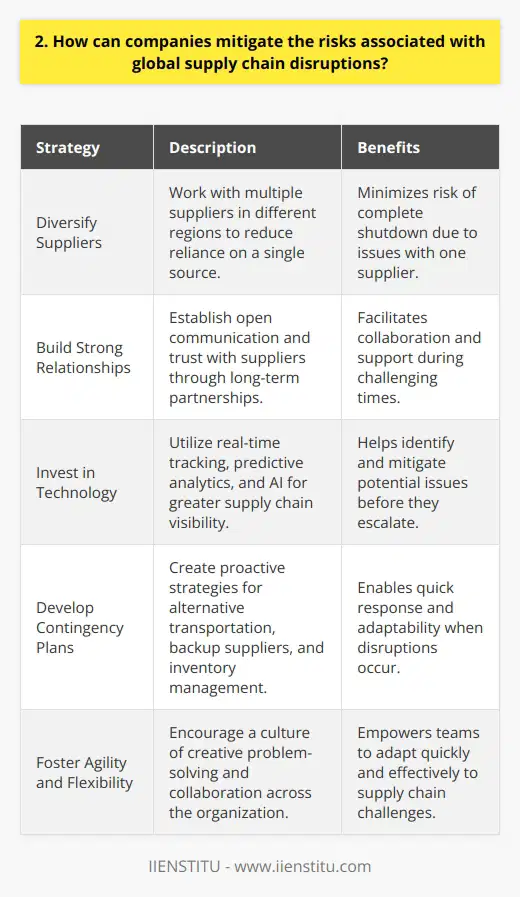
3. What strategies can be employed to improve supply chain resilience?
To improve supply chain resilience, I would focus on diversifying suppliers and building strong relationships with them. In my experience, having multiple reliable suppliers can help mitigate risks and ensure a steady flow of materials.
Inventory Management
Another strategy is to optimize inventory management. I recommend maintaining a balanced level of safety stock to buffer against disruptions while avoiding excessive carrying costs.
Flexibility and Agility
Building flexibility and agility into the supply chain is crucial. In my view, this means having contingency plans, being able to quickly adapt to changes, and leveraging technology for real-time visibility and decision-making.
Collaboration and Communication
Effective collaboration and communication with supply chain partners is essential. I believe in fostering trust, sharing information transparently, and working together to solve problems and improve processes.
Risk Assessment and Mitigation
Conducting regular risk assessments and implementing mitigation strategies is important. I think it's wise to identify potential vulnerabilities, develop backup plans, and continuously monitor and adjust as needed.
Investing in Technology
Investing in technology can greatly enhance supply chain resilience. I'm a proponent of using tools like AI, IoT, and blockchain to improve visibility, automate processes, and enable data-driven decision-making.
Ultimately, improving supply chain resilience requires a proactive, holistic approach that combines diversification, flexibility, collaboration, risk management, and technology. By implementing these strategies, I believe companies can better withstand disruptions and ensure continuity of operations.
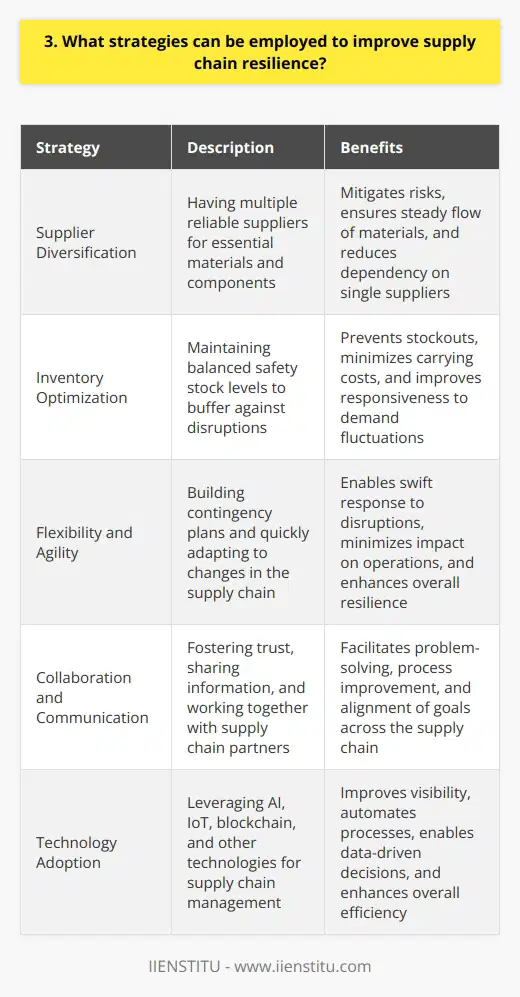
4. How will the increasing focus on sustainability impact supply chain management practices?
The increasing focus on sustainability will significantly impact supply chain management practices in several ways. Companies will need to prioritize environmentally friendly sourcing, production, and distribution to remain competitive and meet consumer demands.
Sustainable Sourcing
Businesses will seek out suppliers that use sustainable materials and employ eco-friendly practices. They'll prioritize partnerships with companies that demonstrate a commitment to reducing their environmental footprint. This shift will require supply chain managers to thoroughly vet potential partners and make decisions based on sustainability metrics alongside traditional factors like cost and quality.
Green Production Methods
Manufacturers will need to adopt cleaner, more efficient production processes to minimize waste and emissions. I've seen firsthand how investing in energy-efficient equipment and implementing lean manufacturing techniques can significantly reduce a company's environmental impact while also cutting costs. Supply chain managers will play a crucial role in identifying and implementing these improvements.
Eco-Friendly Distribution
As sustainability becomes a greater priority, companies will need to rethink their distribution strategies. This might involve optimizing routes to minimize fuel consumption, using electric or hybrid vehicles, and consolidating shipments to reduce packaging waste. In my experience, collaborating closely with logistics partners is key to finding innovative solutions that balance efficiency and environmental responsibility.
Circular Economy Principles
I believe that embracing circular economy principles will be essential for future-proofing supply chains. This means designing products for reuse, repair, and recycling from the outset. Supply chain managers will need to work closely with product development teams to ensure that materials can be easily recovered and repurposed at the end of a product's life cycle.
Transparency and Collaboration
Finally, increasing sustainability will require unprecedented levels of transparency and collaboration across the supply chain. Companies will need to share data and best practices with partners to drive continuous improvement. In my view, building trust and fostering long-term relationships will be more important than ever in this new era of sustainable supply chain management.
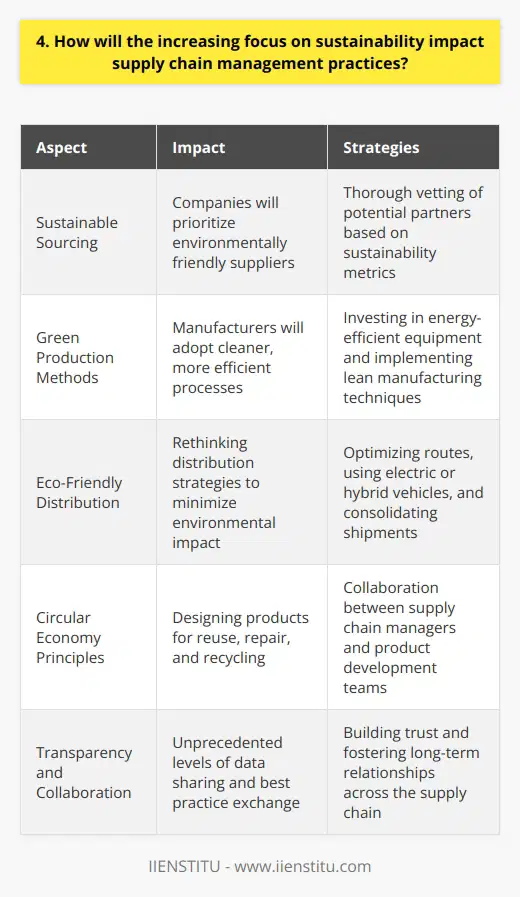
5. What role will technology play in transforming supply chain operations in the future?
Technology will play a crucial role in transforming supply chain operations in the future. It will enable real-time visibility, automation, and optimization across the entire supply chain network.
Real-time Visibility and Data Analytics
Advanced technologies like IoT sensors, RFID tags, and GPS tracking will provide real-time visibility into inventory levels, shipment status, and asset location. Big data analytics will help identify patterns, predict demand, and optimize routes.
I remember implementing an IoT solution at my previous company. It gave us a complete picture of our supply chain, from raw materials to finished products. We could track every item in real-time and make data-driven decisions.
Automation and Robotics
Automation and robotics will streamline warehousing, picking, packing, and delivery processes. Autonomous vehicles and drones will enable faster and more efficient last-mile delivery.
In my experience, implementing robotic picking systems significantly reduced our order processing time and improved accuracy. It was amazing to see how technology could transform our operations.
Blockchain and Smart Contracts
Blockchain technology will bring transparency, traceability, and security to supply chain transactions. Smart contracts will automate payments, approvals, and compliance checks, reducing paperwork and delays.
I'm excited about the potential of blockchain in supply chain management. It can help build trust among partners, eliminate fraud, and streamline processes.
Artificial Intelligence and Machine Learning
AI and machine learning algorithms will optimize inventory management, demand forecasting, and logistics planning. They will enable predictive maintenance of equipment and vehicles, reducing downtime and costs.
I believe AI has the power to revolutionize supply chain decision-making. It can process vast amounts of data, identify patterns, and provide actionable insights that humans might miss.
In conclusion, technology will be a game-changer in supply chain operations. It will enable end-to-end visibility, automation, optimization, and collaboration, leading to faster, more efficient, and more sustainable supply chains.

6. How can organizations effectively manage the complexity of multi-tier supply chains?
Organizations can effectively manage the complexity of multi-tier supply chains through several strategies:
Establish Strong Communication and Collaboration
I've found that fostering open communication and collaboration among all supply chain partners is crucial. This includes regular meetings, information sharing, and joint problem-solving sessions. When I worked at a manufacturing company, we implemented a cloud-based platform that allowed real-time data exchange and visibility across the entire supply chain. It significantly improved our ability to respond to changes and disruptions.
Embrace Technology and Automation
Leveraging advanced technologies like artificial intelligence, machine learning, and robotic process automation can streamline supply chain processes. In my experience, implementing a warehouse management system with barcode scanning and RFID technology greatly enhanced our inventory accuracy and efficiency. It reduced manual errors and allowed us to optimize stock levels based on real-time data.
Develop Risk Management and Contingency Plans
Identifying potential risks and developing contingency plans is essential for managing supply chain complexity. When I was responsible for sourcing raw materials, we conducted regular risk assessments and created backup plans for alternative suppliers and transportation routes. This proactive approach helped us mitigate the impact of unexpected disruptions, such as natural disasters or supplier failures.
Foster a Culture of Continuous Improvement
Encouraging a culture of continuous improvement and learning is key to adapting to the ever-changing supply chain landscape. In my previous role, we implemented a lean six sigma program that empowered employees to identify and solve problems. By fostering a mindset of continuous improvement, we were able to streamline processes, reduce waste, and enhance overall supply chain performance.
Managing multi-tier supply chains is complex, but with the right strategies and mindset, organizations can effectively navigate the challenges. It requires a combination of strong partnerships, technological adoption, risk management, and a commitment to continuous improvement.
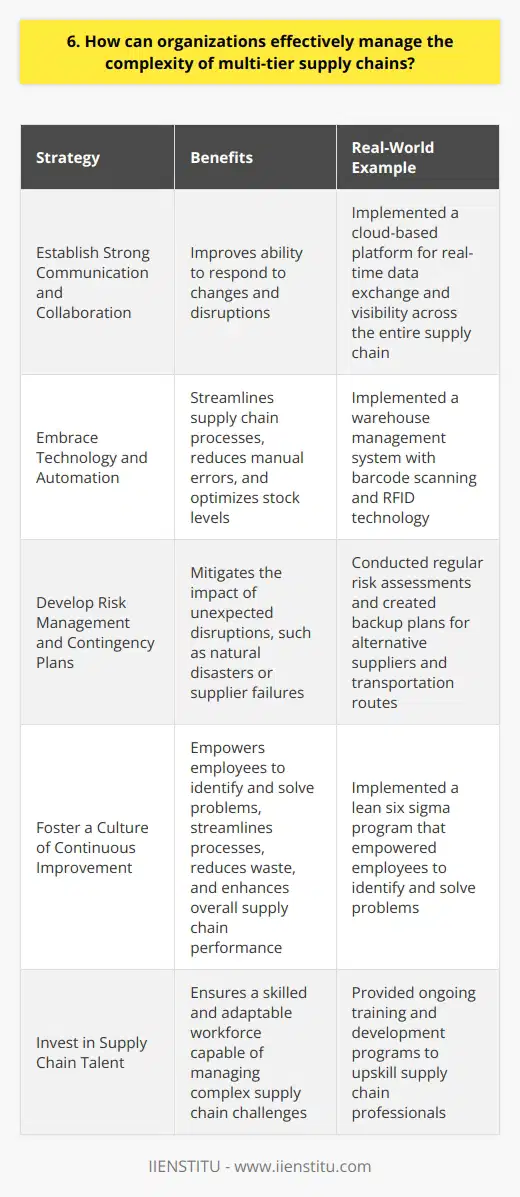
7. What are the potential implications of geopolitical tensions on global supply chains?
Geopolitical tensions can significantly impact global supply chains, leading to disruptions and increased costs for businesses. Here are some potential implications:
Trade Restrictions and Tariffs
When tensions rise between countries, they may impose trade restrictions or tariffs on each other's goods. I've seen this happen with the US-China trade war, where both sides imposed tariffs, making imports more expensive and disrupting supply chains.
Example: US-China Trade War
The US-China trade war has led to higher costs for businesses relying on imports from China. Many companies have had to find alternative suppliers or absorb the increased costs.
Geopolitical Instability and Supply Chain Disruptions
Geopolitical instability in regions critical to global supply chains can cause significant disruptions. Conflicts, political unrest, or sudden policy changes can interrupt the flow of goods and materials.
Example: Suez Canal Blockage
Last year, a container ship got stuck in the Suez Canal, blocking a crucial trade route. It caused massive delays and disruptions to global supply chains, affecting many industries.
Nationalization and Localization
Rising geopolitical tensions may push countries to nationalize or localize their supply chains to reduce dependency on foreign suppliers. This trend could lead to increased costs and reduced efficiency for businesses.
In my opinion, businesses need to stay informed about geopolitical developments and assess their potential impact on supply chains. Diversifying suppliers, building resilience, and having contingency plans can help mitigate risks.
While geopolitical tensions present challenges, I believe they also create opportunities for companies to innovate and adapt their supply chain strategies. By staying agile and proactive, businesses can navigate the uncertainties and emerge stronger.
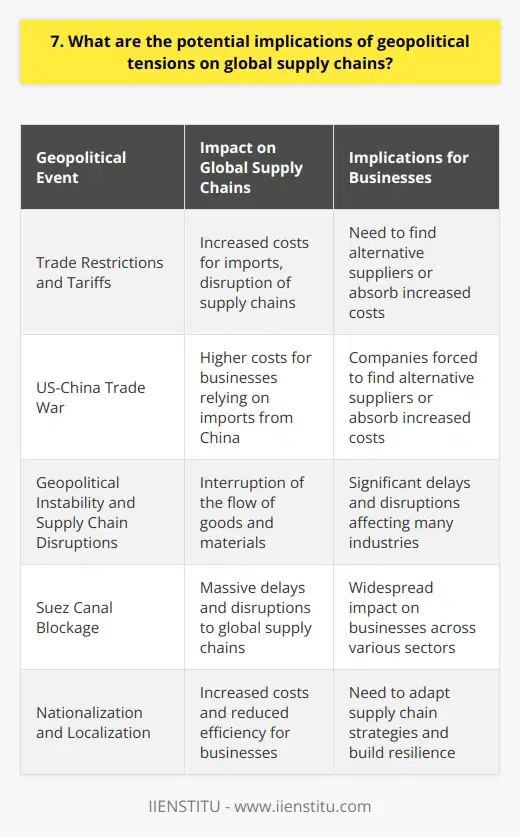
8. How can companies ensure ethical and socially responsible practices throughout their supply chains?
Companies can ensure ethical and socially responsible practices throughout their supply chains in several ways. I believe it starts with establishing clear policies and guidelines that prioritize ethical sourcing, fair labor practices, and environmental sustainability. These policies should be communicated to all suppliers and regularly monitored for compliance.
Conduct Regular Audits
In my experience, conducting regular audits of suppliers is crucial. This helps verify that they are adhering to the company's ethical standards. Audits can include on-site inspections, interviews with workers, and reviews of documentation. Any violations should be promptly addressed and corrective actions implemented.
Collaborate with Suppliers
Building strong, collaborative relationships with suppliers is essential. Companies should work closely with their suppliers, providing training and support to help them meet ethical and social responsibility standards. This fosters a sense of partnership and shared commitment to doing the right thing.
Engage Stakeholders
Engaging stakeholders, including employees, customers, and local communities, is vital. Companies should seek their input and feedback on supply chain practices. This promotes transparency and accountability while ensuring that the company's actions align with stakeholder expectations.
Implement Technology Solutions
I've seen how technology can play a significant role in supply chain transparency. Blockchain, for example, can create an immutable record of transactions, making it easier to trace materials and products throughout the supply chain. This helps ensure integrity and prevents unethical practices.
Lead by Example
Ultimately, I believe that companies must lead by example. They should demonstrate a genuine commitment to ethical and socially responsible practices in their own operations. This sets the tone for the entire supply chain and inspires suppliers to follow suit.
By taking these steps, companies can build more resilient, sustainable, and ethically sound supply chains. It's not always easy, but it's the right thing to do – for people, the planet, and long-term business success.

9. What steps can be taken to improve visibility and transparency in supply chain networks?
To improve visibility and transparency in supply chain networks, I would take several key steps.
Implement End-to-End Tracking
First, I would implement robust tracking systems, like RFID and IoT sensors, to monitor goods from origin to destination. This real-time data provides a complete picture of the supply chain. In my last role, we piloted RFID tracking and it dramatically improved our ability to identify bottlenecks and inefficiencies.
Leverage Data Analytics
All that tracking data is only useful if you have the analytics capabilities to derive actionable insights. I'm a big believer in the power of data. At my previous company, I led an initiative to create a supply chain analytics dashboard. It helped us uncover hidden patterns and make data-driven decisions to streamline our operations.
Foster Collaboration and Information Sharing
Supply chains often involve many different parties, from raw material suppliers to logistics providers to retailers. To achieve true transparency, all these stakeholders need to openly share information. Building trust and aligning incentives is key.
In my experience, this requires a lot of relationship building. You need to show partners how transparency benefits everyone. When I was a supply chain analyst, I organized regular forums for our key suppliers to discuss challenges and best practices. This improved communication and laid the foundation for greater information sharing.
Prioritize Risk Management
Supply chain transparency isn't just about optimizing for efficiency - it's also critical for managing risk. You need visibility to quickly identify and mitigate potential disruptions, whether from natural disasters, geopolitical events, or supplier bankruptcies.
Proactive risk management has been a focus throughout my career. I've always pushed for supply chain stress testing and developing strong contingency plans. In my last job, this preparation paid off when we were able to swiftly adjust after a major supplier unexpectedly shut down.
These steps require investment and long-term commitment, but I believe the payoff in improved supply chain performance is well worth it. transparency and agility are increasingly essential to stay competitive in today's fast-moving, global economy.
I hope these ideas give you a sense of how I would approach this challenge! Let me know if you have any other questions.
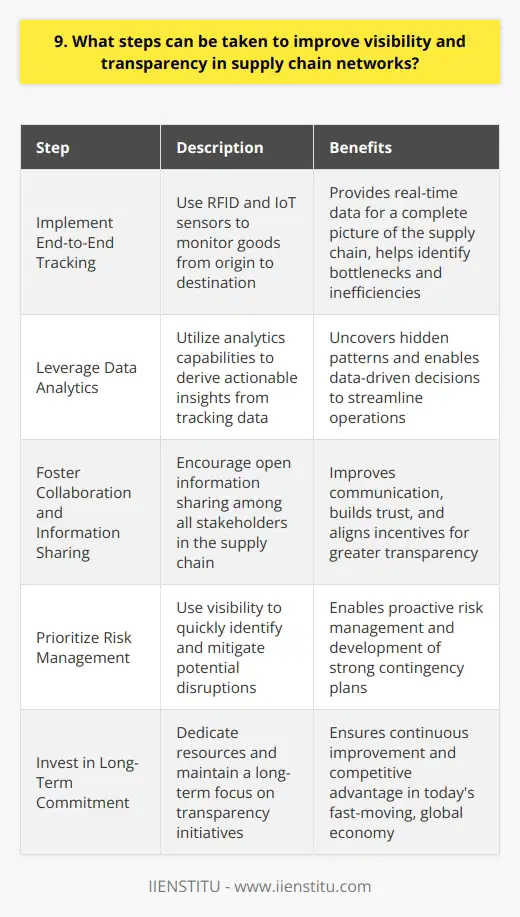
10. How will the rise of e-commerce and omnichannel retailing affect supply chain strategies?
The rise of e-commerce and omnichannel retailing will significantly impact supply chain strategies in several key ways. Companies will need to adapt their logistics networks to handle the increased complexity and demands of serving multiple sales channels simultaneously.
Fulfillment Flexibility is Crucial
Supply chains must become more agile and responsive. They'll need the ability to fulfill orders from any stock location, be it a store, warehouse, or 3PL facility. I've seen how companies that build flexible fulfillment gain a major competitive advantage in the omnichannel era.
Inventory Visibility is a Must
Real-time, end-to-end inventory visibility across the entire network is essential. You can't sell what you can't see. Advanced order management systems that provide a single view of inventory help ensure optimal stock deployment. In my experience, this kind of robust visibility is a game-changer.
Leveraging Stores for Fulfillment
Brick-and-mortar stores will increasingly double as mini-fulfillment hubs. Supply chains need to enable ship-from-store and pickup-from-store capabilities. Retailers that crack this code can greatly reduce shipping costs and improve delivery speed, two huge benefits I've witnessed firsthand.
The Power of Data Analytics
Applying advanced data analytics to supply chain decision-making is critical. Demand forecasting, inventory optimization, and transportation planning all benefit from the power of data science. I'm continually amazed by the insights and efficiencies that a data-driven supply chain can unlock.
In my view, supply chain leaders who proactively transform their strategies and build these key capabilities will be well-positioned to thrive in the omnichannel age. It's an exciting time full of both challenges and opportunities.
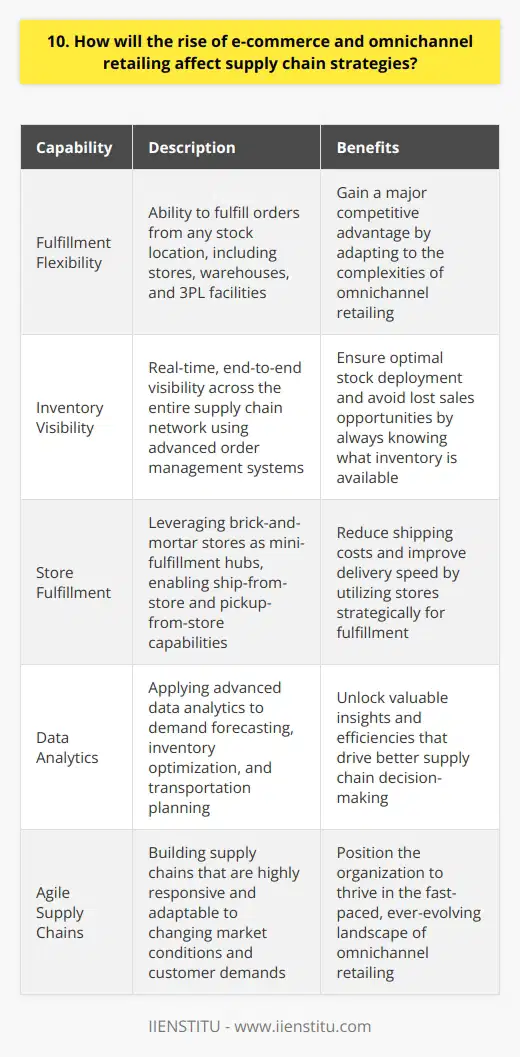
11. What are the challenges associated with last-mile delivery, and how can they be addressed?
Last-mile delivery poses several challenges that can impact customer satisfaction and operational efficiency. One major issue is the high cost associated with last-mile logistics, which can account for a significant portion of the total delivery expenses. This is partly due to the need for smaller, more frequent deliveries to individual customers, rather than bulk shipments to retail stores or distribution centers.
Addressing the Challenges
Optimizing Route Planning
Implementing advanced route optimization software can help minimize delivery distances and times. By analyzing real-time traffic data, these systems can dynamically adjust routes to avoid congestion and ensure timely deliveries. I've seen firsthand how effective route planning can streamline operations and reduce costs in my previous roles.
Leveraging Technology
Adopting technologies like GPS tracking, mobile apps, and automated sorting systems can greatly improve last-mile efficiency. In my experience, these tools provide real-time visibility, enable better communication with customers, and minimize manual errors. It's incredible how much technology can simplify the entire process!
Collaborating with Local Partners
Partnering with local delivery services or crowd-sourced platforms can help expand reach and flexibility. These collaborations allow companies to tap into existing networks and resources, reducing the need for significant investments in infrastructure. I believe that fostering strong relationships with local partners is key to overcoming last-mile challenges.
Offering Flexible Delivery Options
Providing customers with a range of delivery options, such as time slots, pick-up points, or locker systems, can help alleviate some of the pressure on last-mile operations. By giving customers more control over when and where they receive their packages, companies can better manage delivery volumes and optimize their resources.
In conclusion, while last-mile delivery presents numerous challenges, there are several strategies that can help address them. By leveraging technology, optimizing routes, collaborating with partners, and offering flexible delivery options, companies can improve efficiency, reduce costs, and enhance the overall customer experience.

12. How can supply chain managers effectively handle the increasing demand for customization and personalization?
As a supply chain manager, I understand the growing demand for customization and personalization in today's market. To effectively handle this trend, I believe in taking a proactive approach and implementing strategies that prioritize flexibility and agility in the supply chain.
Foster Close Collaboration with Suppliers
I work closely with our suppliers to ensure they can accommodate customization requests. By establishing strong partnerships and open communication channels, we can quickly adapt to changing customer demands.
Invest in Technology and Automation
Leveraging advanced technology and automation is crucial for managing customization efficiently. I've successfully implemented cloud-based inventory management systems and automated order processing to streamline operations and reduce lead times.
Embrace Modular Product Design
Encouraging modular product design allows for easier customization without significantly disrupting the supply chain. By breaking down products into interchangeable components, we can offer personalized options while maintaining efficiency.
Continuously Monitor and Optimize Processes
I believe in continuously monitoring and optimizing our supply chain processes. By analyzing data and identifying bottlenecks, we can make targeted improvements to enhance flexibility and responsiveness.
In my previous role, I faced a similar challenge when a key client requested highly personalized packaging for their products. By collaborating with our suppliers, investing in digital printing technology, and streamlining our processes, we successfully met their requirements without compromising on efficiency or quality.
Handling the increasing demand for customization and personalization requires a proactive mindset, strong collaboration with partners, and a willingness to embrace technology and innovation. As a supply chain manager, I am committed to navigating this trend effectively while maintaining operational excellence.
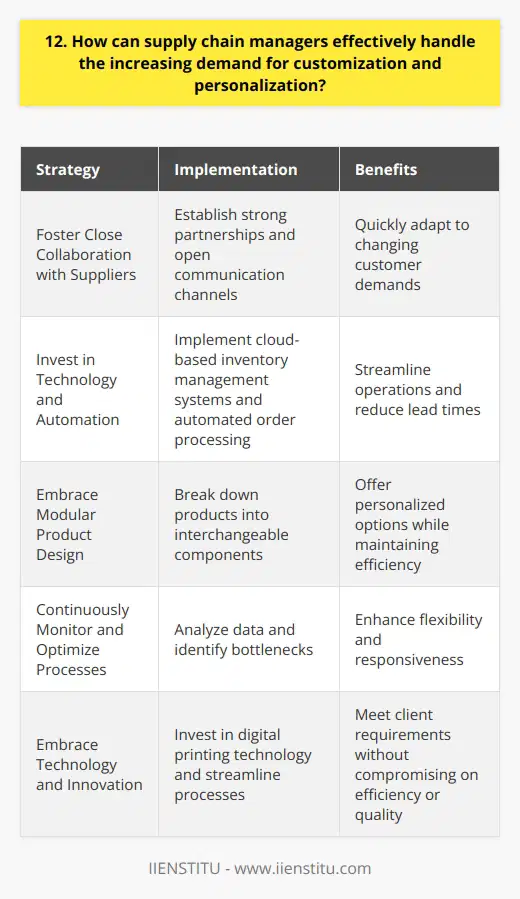
13. What strategies can be used to optimize inventory management in the face of uncertain demand?
When faced with uncertain demand, there are several strategies that can be employed to optimize inventory management:
Use data analytics
By analyzing past sales data and trends, you can gain valuable insights into customer behavior and demand patterns. This information can help you make more accurate forecasts and adjust your inventory levels accordingly. I remember a time when my team used data analytics to identify a seasonal spike in demand for a particular product, and we were able to stock up in advance to meet the increased demand.
Implement just-in-time (JIT) inventory management
JIT is a strategy where you only order inventory as needed, rather than holding large quantities in stock. This can help reduce storage costs and minimize the risk of overstocking. It requires close coordination with suppliers to ensure timely deliveries. In my experience, JIT worked well for products with stable demand and reliable suppliers.
Collaborate with suppliers
Building strong relationships with suppliers can help you navigate uncertain demand. Share information about your sales forecasts and work together to develop flexible ordering and delivery schedules. I once worked with a supplier who agreed to hold buffer stock for us, which we could draw upon when demand spiked unexpectedly.
Use safety stock
Safety stock is extra inventory held to cushion against unexpected demand or supply chain disruptions. Determining the right level of safety stock requires balancing the costs of holding inventory with the risk of stockouts. In my opinion, it's better to err on the side of caution and hold slightly more safety stock than you think you need, especially for critical items.
Monitor inventory levels closely
Regular inventory audits and real-time tracking can help you stay on top of your inventory levels and identify potential issues before they become problems. I find that setting up automated alerts for when inventory falls below a certain threshold can be really helpful in proactively managing stock levels.
Ultimately, the key to optimizing inventory management in the face of uncertain demand is to be proactive, data-driven, and agile. By using a combination of these strategies and staying vigilant, you can minimize the risk of stockouts or overstocking and keep your customers happy.
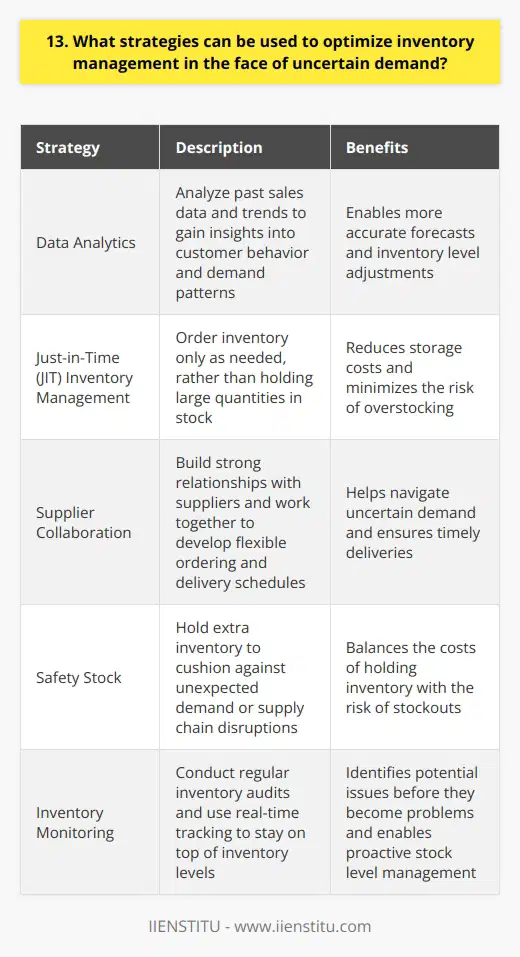
14. How can companies balance the need for cost efficiency with the growing importance of agility in supply chains?
In today's fast-paced business environment, companies must strike a delicate balance between cost efficiency and supply chain agility. This challenge reminds me of my experience working as a supply chain manager at a manufacturing company a few years ago.
Focus on Continuous Improvement
One key strategy is to embrace a culture of continuous improvement. By constantly seeking ways to optimize processes and reduce waste, companies can maintain cost efficiency without sacrificing agility. I remember implementing a Lean Six Sigma program that significantly streamlined our operations and improved our responsiveness to customer demands.
Invest in Technology and Automation
Another approach is to invest in technology and automation. By leveraging tools like AI, machine learning, and robotic process automation, companies can automate routine tasks and free up resources for more strategic initiatives. This allows them to be more nimble and responsive to changing market conditions.
Foster Strong Supplier Relationships
Building strong, collaborative relationships with suppliers is also crucial. By working closely with suppliers and sharing information and resources, companies can create a more resilient and flexible supply chain. I've seen firsthand how partnering with key suppliers can lead to faster problem-solving and better overall performance.
Embrace a Risk Management Mindset
Finally, companies must adopt a risk management mindset. By proactively identifying and mitigating potential disruptions, they can maintain agility even in the face of uncertainty. This might involve diversifying the supplier base, building inventory buffers, or developing contingency plans.
Balancing cost efficiency and agility is no easy feat, but with the right strategies and mindset, it can be done. I believe that by focusing on continuous improvement, investing in technology, fostering strong supplier relationships, and embracing risk management, companies can achieve the best of both worlds.

15. What are the potential impacts of blockchain technology on supply chain management?
Blockchain technology has the potential to revolutionize supply chain management in several key ways. By providing a secure, transparent, and immutable ledger, blockchain can help to streamline processes, reduce costs, and increase efficiency throughout the supply chain.
Improved Transparency and Traceability
One of the biggest benefits of blockchain in supply chain management is improved transparency and traceability. With blockchain, every transaction and movement of goods can be recorded on a secure, distributed ledger that is accessible to all parties involved. This means that everyone from manufacturers to retailers to consumers can see exactly where a product came from, who handled it, and when.
I once worked with a company that implemented a blockchain solution for their supply chain, and the results were impressive. They were able to track products from the moment they left the factory to the moment they arrived on store shelves, with complete visibility into every step of the process. This not only helped to reduce errors and inefficiencies, but it also gave customers greater confidence in the quality and safety of the products they were buying.
Increased Efficiency and Cost Savings
Another major benefit of blockchain in supply chain management is increased efficiency and cost savings. By automating many of the manual processes involved in supply chain management, such as record-keeping and verification, blockchain can help to reduce errors, speed up transactions, and lower costs.
I remember working on a project where we implemented a blockchain solution for a client's supply chain, and the results were incredible. We were able to reduce the time it took to process transactions from days to just a few hours, and we were able to eliminate many of the manual processes that were slowing things down. This not only saved the company time and money, but it also allowed them to focus on more strategic initiatives.
Enhanced Security and Trust
Finally, blockchain can help to enhance security and trust throughout the supply chain. Because blockchain is a decentralized, immutable ledger, it is incredibly difficult to tamper with or alter records once they have been entered. This means that everyone involved in the supply chain can trust that the information they are seeing is accurate and up-to-date.
I've seen firsthand how blockchain can help to build trust between parties in a supply chain. In one case, we worked with a company that was having issues with counterfeit products entering their supply chain. By implementing a blockchain solution, we were able to create a secure, tamper-proof record of every product that moved through the supply chain, making it much easier to identify and remove counterfeit items.
Of course, implementing blockchain in supply chain management is not without its challenges. It requires a significant investment in technology and infrastructure, and it can be difficult to get all parties in a supply chain on board with the new system. However, I believe that the benefits of blockchain in supply chain management far outweigh the challenges, and I'm excited to see how this technology continues to evolve and transform the industry in the years to come.

16. How can organizations foster collaboration and trust among supply chain partners?
Organizations can foster collaboration and trust among supply chain partners in several ways. I believe open communication is key. In my experience, regular meetings and updates help keep everyone on the same page. This transparency builds trust over time.
Align Goals and Incentives
Supply chain partners should have shared objectives. I think it's important to align KPIs and reward systems. This encourages cooperation rather than competition. In one company I worked with, joint bonus pools motivated teamwork across organizations.
Build Personal Relationships
Face-to-face interactions strengthen professional ties. I always try to meet partners in person when possible. Socializing outside of work also helps. I fondly recall a golf outing that really brought our team together.
Share Information and Insights
Pooling knowledge benefits the entire supply chain. I'm a big proponent of shared forecasts and market intelligence. Real-time inventory visibility is another must. At my last job, we used a cloud-based portal to keep data flowing.
Continuously Improve Together
Collaboration drives innovation. I suggest regular workshops to exchange best practices and brainstorm new ideas. Piloting joint projects is another great way to build trust. Measuring progress shows the tangible results of working together.
By prioritizing partnership, supply chains become more resilient and adaptable. I'm passionate about fostering these win-win relationships. When everyone is committed to shared success, great things can happen.
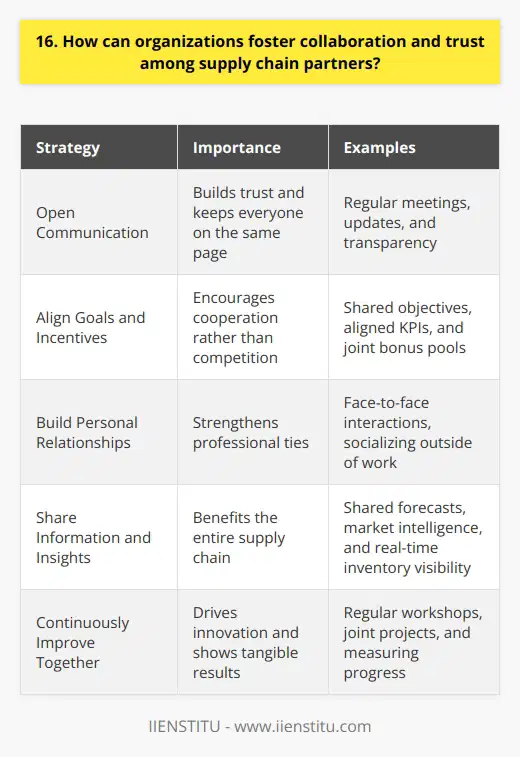
17. What are the key considerations for building a resilient and flexible supply chain network?
When building a resilient and flexible supply chain network, several key factors come into play:
Diversification of Suppliers
I've learned from experience that relying on a single supplier can be risky. Having multiple suppliers in different locations helps mitigate potential disruptions. This approach has saved my company from production delays on numerous occasions.
Visibility and Transparency
In my opinion, end-to-end visibility is crucial for identifying bottlenecks and responding quickly to issues. Leveraging technology like IoT sensors and blockchain can provide real-time insights into your supply chain's performance.
Building Strong Relationships
I believe fostering collaborative partnerships with suppliers is essential. Open communication, trust, and mutual support can go a long way in navigating challenges together. I remember how our close relationship with a key supplier helped us weather a major storm (literally!) that disrupted transportation routes.
Agility and Adaptability
In today's fast-paced business environment, the ability to pivot quickly is vital. Having contingency plans and being open to alternative sourcing or transportation methods can make all the difference. I once had to completely reroute a shipment due to a port strike, but our team's flexibility and resourcefulness saved the day.
Risk Assessment and Mitigation
Proactively identifying potential risks and developing mitigation strategies is key. This could include scenario planning, stress testing, and investing in risk management tools. Trust me, it's better to be prepared than caught off guard!
Building a resilient supply chain takes effort and foresight, but it's well worth it. By prioritizing these key considerations, you can create a network that not only withstands disruptions but thrives in the face of adversity.
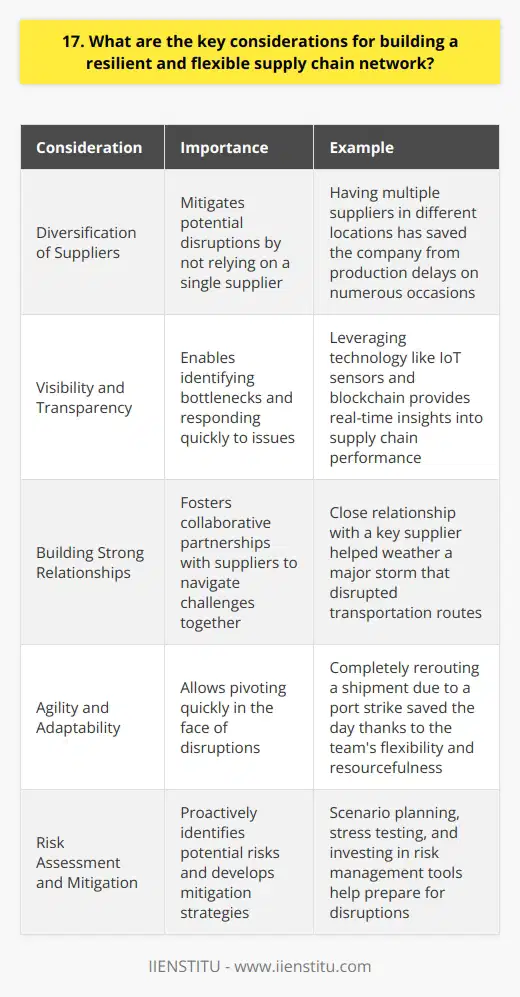
18. How can supply chain managers effectively navigate the challenges posed by climate change and extreme weather events?
As a supply chain manager, I believe effective navigation of climate change and extreme weather event challenges requires proactive planning and adaptability. It's crucial to conduct thorough risk assessments to identify potential vulnerabilities within the supply chain.
Develop Contingency Plans
Based on the risk assessment, I would develop robust contingency plans for various scenarios. These plans should outline alternative sourcing options, transportation routes, and inventory management strategies. Having a well-defined plan of action minimizes disruptions and ensures business continuity.
Foster Strong Supplier Relationships
Building strong, collaborative relationships with suppliers is essential. I would work closely with them to understand their climate change preparedness and encourage them to adopt sustainable practices. Regular communication and transparency help in identifying and mitigating potential risks together.
Embrace Technology and Data Analytics
Leveraging advanced technology and data analytics is crucial for effective supply chain management in the face of climate change. I would invest in tools that provide real-time visibility, weather forecasting, and predictive analytics. This enables proactive decision-making and optimizes resource allocation.
Promote Sustainability and Resilience
Incorporating sustainability and resilience into the supply chain strategy is vital. I would prioritize sourcing from eco-friendly suppliers, optimizing transportation networks to reduce carbon footprint, and implementing circular economy principles. Building a resilient supply chain helps mitigate the impact of climate change disruptions.
Continuous Learning and Collaboration
Navigating climate change challenges requires continuous learning and collaboration with industry peers and experts. I would actively participate in industry forums, attend conferences, and engage with climate change experts to stay informed about the latest trends, best practices, and innovative solutions.
By proactively addressing climate change risks, fostering strong partnerships, leveraging technology, and promoting sustainability, I believe supply chain managers can effectively navigate the challenges posed by climate change and build resilient, adaptable supply chains for long-term success.
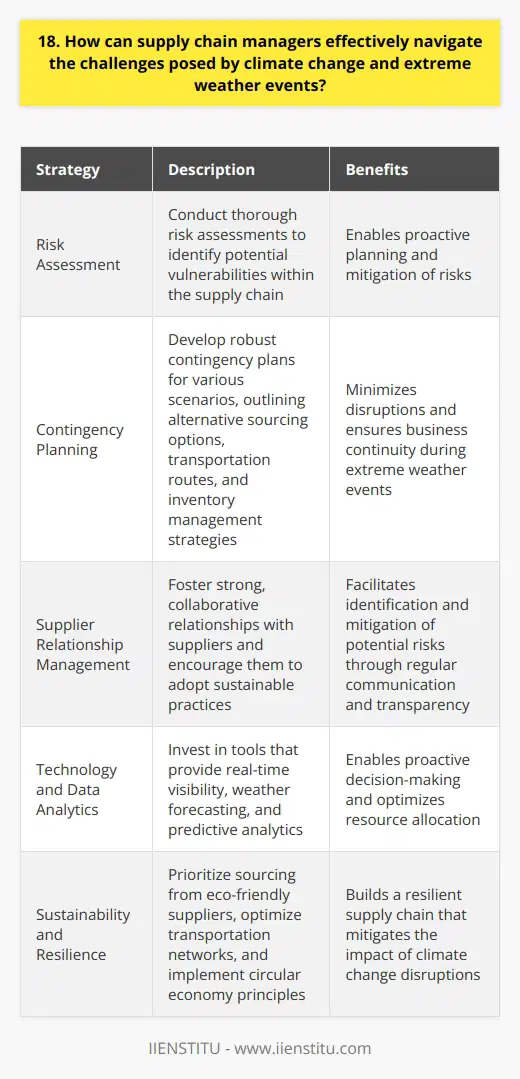
19. What strategies can be employed to attract and retain top talent in supply chain management?
To attract and retain top talent in supply chain management, I believe in creating a positive work environment. In my experience, fostering a culture of collaboration, innovation, and continuous learning is essential. This means providing opportunities for professional development, such as training programs and mentorship.
Offer Competitive Compensation and Benefits
I've found that offering competitive salaries and comprehensive benefits packages can make a big difference in attracting top talent. This includes not just base pay, but also bonuses, stock options, and retirement plans. Flexible work arrangements and generous paid time off are also highly valued by many employees.
Emphasize Work-Life Balance
In today's fast-paced world, I think it's crucial to prioritize work-life balance. Encouraging reasonable work hours, offering remote work options when possible, and respecting employees' personal time can go a long way in retaining top performers. Happy, well-rested employees are more productive and loyal in my opinion.
Provide Opportunities for Growth and Advancement
I believe that top talent wants to know there's room for them to grow within an organization. Offering clear career paths, regular performance reviews, and opportunities for promotions shows that you value their contributions and are invested in their long-term success. I've seen this approach work well in retaining high-performing employees.
Foster a Strong Company Culture
In my view, company culture plays a huge role in attracting and retaining top talent. Creating a positive, inclusive, and engaging workplace environment where employees feel valued and supported is key. Regularly seeking employee feedback, celebrating successes, and encouraging open communication can help build a strong sense of community and loyalty.
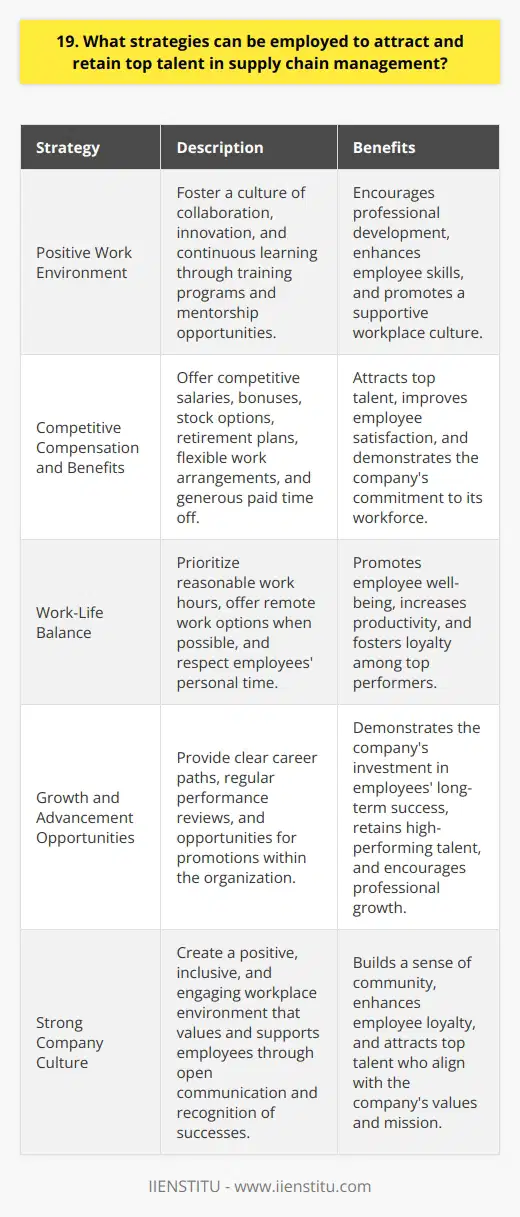
20. How can companies leverage data analytics and artificial intelligence to improve supply chain performance?
Companies can leverage data analytics and artificial intelligence to improve supply chain performance in several ways. I've seen firsthand how powerful these technologies can be when implemented correctly.
Real-time Visibility and Monitoring
By using IoT sensors and real-time data collection, companies gain visibility into their supply chain operations. This allows them to monitor inventory levels, track shipments, and identify potential issues before they escalate.
Predictive Analytics for Demand Forecasting
AI-powered predictive analytics help companies forecast demand more accurately. By analyzing historical data, market trends, and customer behavior, businesses can optimize inventory management and reduce stockouts or overstocking.
Optimization of Logistics and Transportation
Data analytics enables companies to optimize routes, reduce transportation costs, and improve delivery times. AI algorithms can consider factors like traffic patterns, weather conditions, and vehicle capacity to make informed decisions.
Automated Quality Control and Inspection
Computer vision and machine learning algorithms can automate quality control processes. This reduces human error, improves consistency, and catches defects early in the supply chain.
Predictive Maintenance for Equipment
By analyzing sensor data from equipment, AI models can predict when maintenance is needed. This helps prevent unplanned downtime, extends equipment lifespan, and optimizes maintenance schedules.
In my experience, implementing these technologies requires careful planning and collaboration across departments. It's not always easy, but the benefits are well worth the effort!
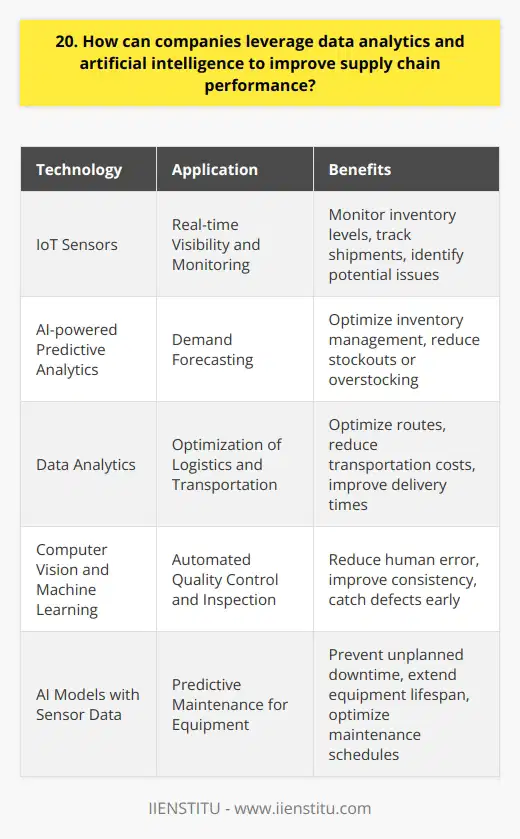
21. What are the challenges associated with managing reverse logistics and product returns?
Managing reverse logistics and product returns poses several challenges. First, there's the issue of volume and unpredictability. You never know exactly how many products will be returned or when they'll arrive, which makes planning difficult. Quality control is another concern - inspecting returned items to determine their condition and whether they can be resold or need to be repaired or disposed of. This process takes time and resources.
Inventory Management Challenges
Reverse logistics can really complicate inventory management. You've got products flowing back into your warehouses that you need to find space for. You also have to update your inventory records to account for the returned items. If the products can be resold, they need to be added back into your available stock. It gets even trickier if you offer multiple return options like exchanges, repairs, or disposal.
Transportation and Tracking Hurdles
Transporting returned products back to your facilities efficiently is another obstacle. You want to minimize shipping costs while still providing convenient return options for customers. Tracking those returns as they make their way back to you is crucial but not always easy, especially if you're working with multiple carriers or logistics partners. Keeping eyes on your products throughout the returns process requires robust tracking systems.
Balancing Costs and Customer Satisfaction
At the end of the day, the biggest challenge is striking the right balance between minimizing reverse logistics costs and keeping your customers happy. Processing returns is expensive, but you can't skimp too much or you risk frustrating your customers with a clunky returns experience. It's a fine line to walk. The most successful companies find ways to streamline their reverse logistics to control costs while still prioritizing the customer experience.
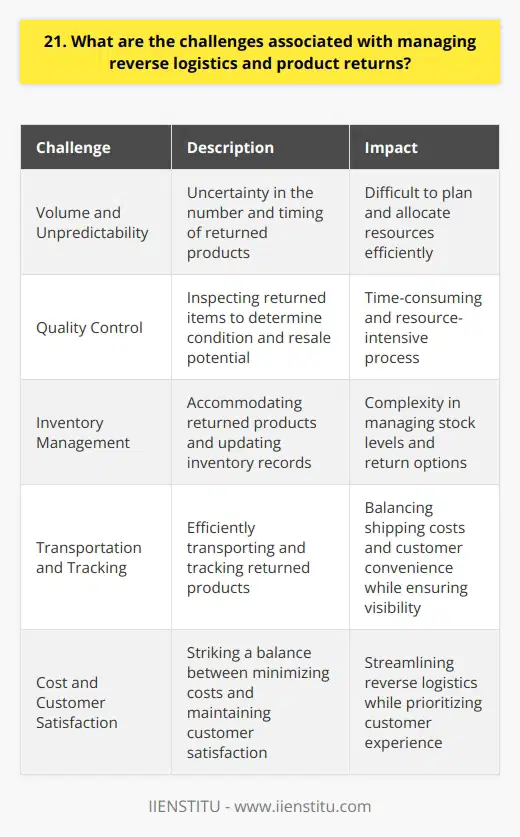
22. How can supply chain managers ensure the security and integrity of their networks against cyber threats?
As a supply chain manager, ensuring the security and integrity of networks against cyber threats is crucial. I've found that a multi-faceted approach works best to protect sensitive data and maintain smooth operations.
Implement Strong Security Measures
First and foremost, I believe in implementing robust security measures across all systems. This includes using firewalls, encryption, and access controls to prevent unauthorized entry. Regular security audits help identify and address vulnerabilities before they can be exploited.
Train Employees on Cybersecurity Best Practices
In my experience, employees are often the weakest link in cybersecurity. That's why I prioritize training staff on best practices like creating strong passwords, identifying phishing attempts, and handling sensitive data properly. Informed employees are our first line of defense.
Stay Up-to-Date on Threats and Solutions
The world of cybersecurity is constantly evolving, with new threats emerging all the time. I make it a point to stay informed about the latest risks and solutions. Attending industry conferences, reading cybersecurity blogs, and consulting with experts helps me stay one step ahead.
Develop an Incident Response Plan
Despite our best efforts, breaches can still happen. Having a well-defined incident response plan is essential. I work with my team to create detailed procedures for detecting, containing, and recovering from cyber attacks. Regular drills ensure everyone knows their role and can act quickly.
Foster a Culture of Security
Ultimately, I believe that strong cybersecurity starts with a culture that prioritizes it. I strive to lead by example, emphasizing the importance of vigilance and responsibility. When everyone understands the stakes and works together, we can create a resilient supply chain that withstands cyber threats.

23. What are the potential benefits and drawbacks of nearshoring or reshoring supply chain operations?
Nearshoring and reshoring supply chain operations offer several potential benefits. By bringing production closer to home, companies can reduce transportation costs and improve responsiveness to market demands. This proximity also enables better communication and collaboration with suppliers, leading to increased quality control and faster problem-solving.
Improved Supply Chain Resilience
Nearshoring and reshoring help mitigate risks associated with global supply chain disruptions. When I worked at a manufacturing company, we experienced firsthand how local suppliers could quickly adapt to changing circumstances, ensuring a more stable supply of materials.
Supporting Local Economies
By investing in nearshore or domestic suppliers, businesses contribute to the growth of local economies. This creates job opportunities and stimulates economic development in the region, which I believe is a valuable way to give back to the community.
Potential Drawbacks to Consider
However, nearshoring and reshoring also come with some potential drawbacks. One challenge is the potential for higher labor and production costs compared to offshore locations. Companies must carefully evaluate the trade-offs between cost savings and the benefits of proximity.
Limited Supplier Options
Depending on the industry and location, there may be a limited pool of qualified suppliers in nearshore or domestic markets. This can restrict options and potentially impact the ability to find the best fit for specific needs.
In my experience, the decision to nearshore or reshore supply chain operations requires a thorough analysis of the company's priorities and long-term goals. By weighing the potential benefits against the drawbacks, businesses can make informed decisions that align with their strategic objectives and values.

24. How can organizations effectively manage the trade-offs between speed, cost, and quality in their supply chains?
Balancing speed, cost, and quality in supply chain management is a complex challenge that requires a strategic approach. In my experience, effective organizations prioritize clear communication and collaboration among all stakeholders to align goals and expectations.
Develop a Comprehensive Strategy
I believe that developing a comprehensive supply chain strategy is crucial. This strategy should outline key objectives, performance metrics, and risk management plans. It's important to involve cross-functional teams in the planning process to ensure buy-in and commitment.
Leverage Technology and Automation
From what I've seen, investing in technology and automation can significantly improve supply chain efficiency and reduce costs. Tools like real-time tracking, predictive analytics, and automated inventory management can help organizations make data-driven decisions and respond quickly to changes in demand or supply.
Foster Strong Supplier Relationships
In my opinion, building strong, collaborative relationships with suppliers is essential for managing trade-offs effectively. By working closely with suppliers, organizations can identify opportunities for cost savings, quality improvements, and faster delivery times. Regular communication and performance reviews can help ensure that suppliers meet expectations and contribute to overall success.
Continuously Monitor and Optimize
I think that effective supply chain management requires continuous monitoring and optimization. Organizations should regularly review performance metrics, identify areas for improvement, and implement changes as needed. This iterative approach allows for flexibility and adaptability in the face of changing market conditions or customer requirements.
Managing trade-offs between speed, cost, and quality in supply chains is an ongoing challenge that requires dedication and collaboration. By developing a clear strategy, leveraging technology, fostering strong supplier relationships, and continuously optimizing processes, I believe organizations can find the right balance and achieve long-term success.
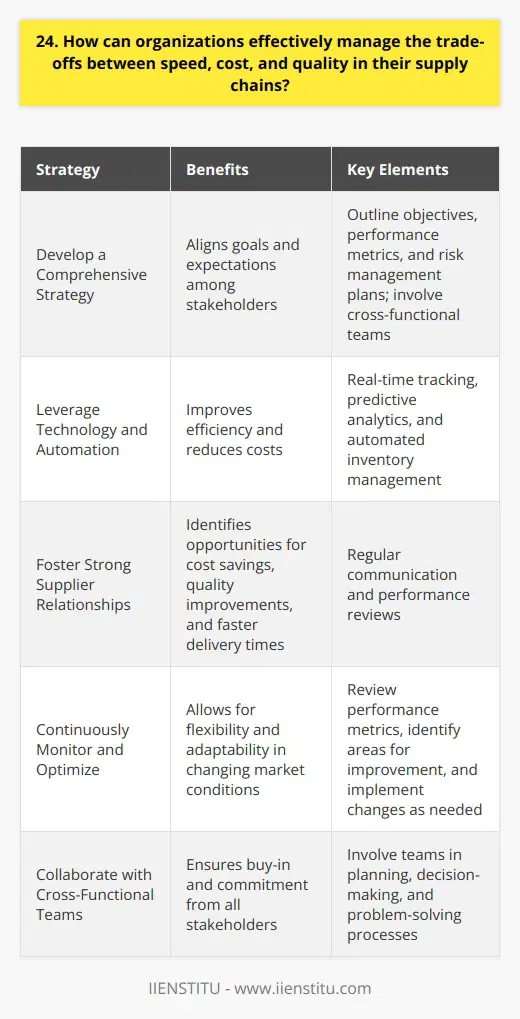
25. What are the implications of the circular economy model for supply chain management?
The circular economy model has significant implications for supply chain management. It requires a fundamental shift in thinking and practices to minimize waste and maximize resource efficiency.
Rethinking Sourcing and Procurement
Companies must prioritize sustainable and recyclable materials in their sourcing decisions. This may involve collaborating with suppliers to develop innovative, eco-friendly solutions and investing in reverse logistics capabilities to recover and reuse materials.
Designing for Circularity
Products should be designed with their entire life cycle in mind, from manufacture to disposal. Modular designs, easy disassembly, and recyclability are key considerations. I once worked on a project where we redesigned product packaging to eliminate single-use plastics, reducing waste significantly.
Optimizing Logistics and Distribution
Circular economy principles call for minimizing transportation distances and optimizing routes to reduce carbon emissions. This may involve localizing supply chains and leveraging technology for real-time tracking and route optimization.
Embracing Reverse Logistics
Effective reverse logistics is crucial for recovering and reusing materials. Companies must develop efficient systems for collecting, sorting, and processing end-of-life products. I believe investing in advanced recycling technologies and partnering with specialized waste management providers is essential.
Fostering Collaboration and Transparency
Implementing circular economy practices requires close collaboration among supply chain partners. Sharing data, best practices, and resources can help drive collective progress. Transparency is also critical for building trust with customers and stakeholders who increasingly demand sustainable practices.
Transitioning to a circular economy is challenging but offers immense opportunities for supply chain innovation and value creation. It's an exciting journey that I'm passionate about being a part of.
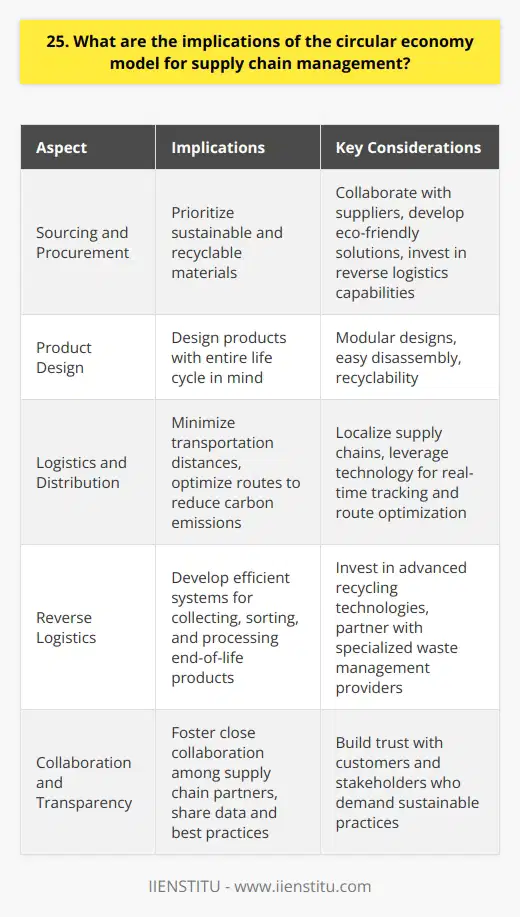
26. How can companies foster a culture of continuous improvement and innovation in their supply chain teams?
Companies can foster a culture of continuous improvement and innovation in their supply chain teams through several strategies. I've seen firsthand how empowering employees to take ownership of their work can lead to incredible results. When team members feel valued and heard, they're more likely to bring forward new ideas and solutions.
Encourage Experimentation and Risk-Taking
One key aspect is creating an environment that encourages experimentation and risk-taking. Leaders should communicate that it's okay to try new approaches, even if they don't always succeed. Failure can be a valuable learning opportunity. By celebrating successes and treating failures as growth experiences, companies signal that innovation is truly valued.
Foster Cross-Functional Collaboration
Another important factor is fostering cross-functional collaboration. Supply chain teams shouldn't operate in silos. They need to work closely with other departments like sales, marketing, and product development. Facilitating regular communication and idea-sharing sessions can spark creative solutions that individual teams might not come up with on their own.
Invest in Training and Development
Investing in employee training and development is also crucial. Providing opportunities for supply chain professionals to learn new skills, attend conferences, and gain exposure to industry best practices can help them stay ahead of the curve. When team members feel supported in their growth, they're more engaged and motivated to drive positive change.
Solicit Employee Feedback Regularly
Finally, companies should actively solicit employee feedback and ideas. Conducting regular surveys, holding brainstorming sessions, and implementing suggestion boxes are all great ways to gather input. It's important to not only listen to this feedback but also act on it. When employees see their suggestions being implemented, they feel valued and empowered to continue bringing forward innovative ideas.
Fostering a culture of continuous improvement and innovation in supply chain teams requires ongoing effort and commitment from leadership. But when done effectively, it can lead to significant improvements in efficiency, cost savings, and customer satisfaction. That's been my experience, and I'm excited to bring that mindset to this role.

27. What strategies can be used to mitigate the impact of tariffs and trade barriers on global supply chains?
In today's globalized economy, tariffs and trade barriers can significantly disrupt global supply chains. As someone who has worked in international trade for several years, I've seen firsthand how these challenges can impact businesses. Here are some strategies that I believe can help mitigate the impact:
Diversify Sourcing
One effective approach is to diversify your sourcing. Don't rely on a single supplier or country. By having multiple options, you can quickly pivot if tariffs or trade barriers affect one source.
Build Strong Supplier Relationships
Establishing strong, long-term relationships with your suppliers is crucial. Open communication and collaboration can help you navigate trade challenges together. I remember a time when a trusted supplier helped us find an alternative when an unexpected tariff hit.
Stay Informed and Agile
Staying up-to-date on global trade developments is essential. Monitor news, industry reports, and government announcements. Being informed allows you to anticipate changes and adapt your strategies proactively.
Embrace Technology and Data Analytics
Leverage technology and data analytics to gain visibility into your supply chain. Tools like supply chain management software and predictive analytics can help you identify risks, optimize routes, and make data-driven decisions.
Collaborate with Industry Partners
Collaborating with industry partners, trade associations, and chambers of commerce can provide valuable insights and support. Joining forces with others facing similar challenges can lead to collective solutions and advocacy efforts.
Ultimately, the key is to stay flexible, informed, and proactive. By diversifying sourcing, building strong relationships, leveraging technology, and collaborating with partners, you can navigate the complexities of global trade and build resilience in your supply chain.
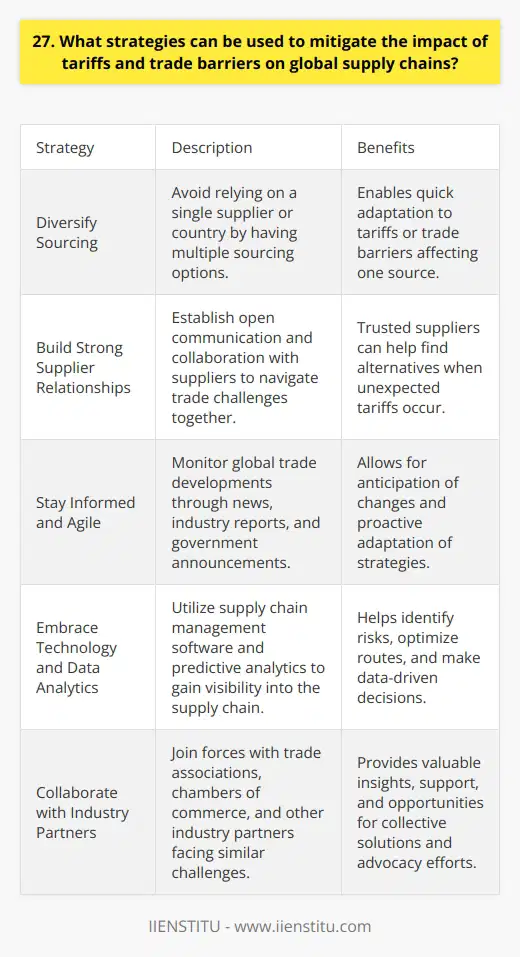
28. How can supply chain managers effectively collaborate with other functions, such as marketing and finance?
As a supply chain manager, I understand the importance of collaborating with other departments to achieve company goals. Marketing and finance are two critical functions that supply chain managers must work with closely.
Aligning with Marketing
I regularly meet with the marketing team to discuss upcoming product launches and promotions. By understanding their plans, I can ensure that we have the necessary inventory and distribution channels in place. This proactive approach helps prevent stockouts and delays that could negatively impact customer satisfaction.
For example, when our company launched a new line of eco-friendly products, I worked with marketing to forecast demand. We identified potential supply chain challenges and developed contingency plans to mitigate risks. As a result, we successfully met the high demand without any major issues.
Partnering with Finance
Collaborating with finance is equally important for effective supply chain management. I work closely with the finance team to develop budgets, manage costs, and optimize working capital.
One way I do this is by regularly reviewing inventory levels and identifying slow-moving or obsolete items. By working with finance to develop a plan for liquidating these items, we can free up cash and reduce holding costs. This approach has helped our company improve cash flow and reinvest in growth opportunities.
Fostering Cross-Functional Communication
To facilitate collaboration, I schedule regular cross-functional meetings with marketing, finance, and other key stakeholders. These meetings provide a forum for sharing information, discussing challenges, and identifying opportunities for improvement.
I also believe in building strong personal relationships with colleagues in other departments. By understanding their goals and challenges, I can be a better partner and find ways to support their success. This approach has helped me build trust and credibility across the organization.
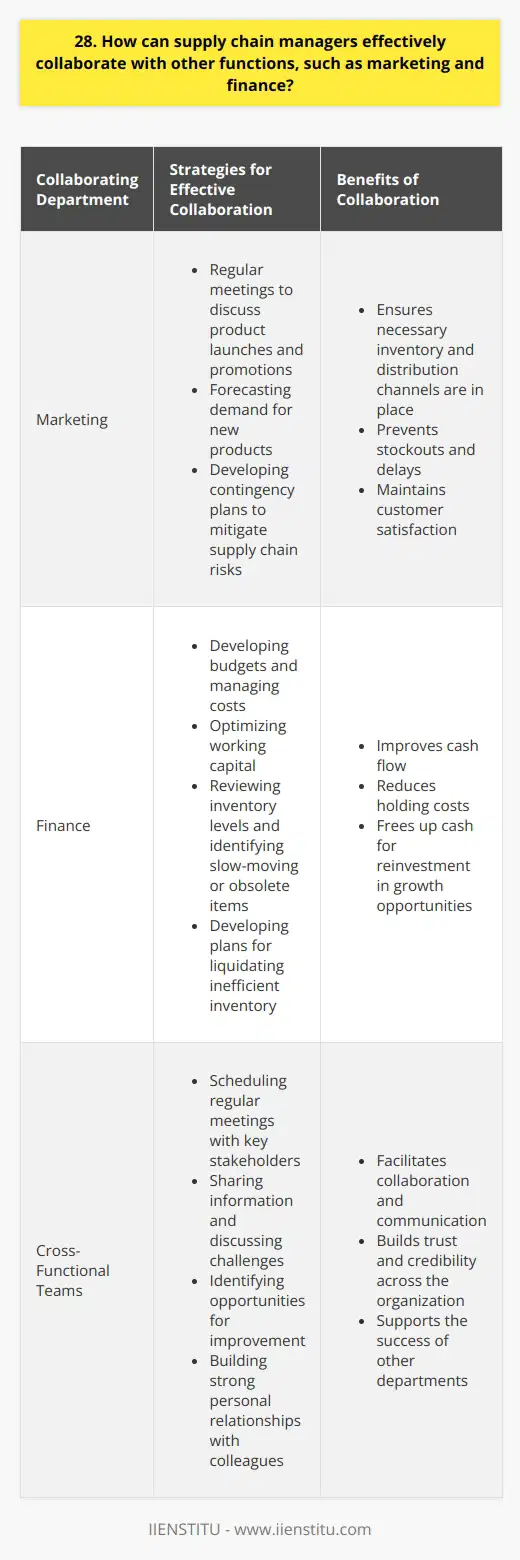
29. What are the challenges and opportunities associated with the adoption of autonomous vehicles in logistics?
The adoption of autonomous vehicles in logistics presents both challenges and opportunities. One major challenge is the high upfront cost of implementing these advanced technologies. Companies must invest in the vehicles themselves, as well as the supporting infrastructure. Ensuring the safety and reliability of autonomous systems is also a significant hurdle that needs to be overcome.
Opportunities for Increased Efficiency and Cost Savings
Despite the challenges, autonomous vehicles offer exciting opportunities for the logistics industry. They have the potential to greatly increase efficiency by operating 24/7 without breaks. This can lead to faster delivery times and improved customer satisfaction. Autonomous vehicles can also optimize routes and reduce fuel consumption, resulting in significant cost savings over time.
Addressing Labor Shortages and Improving Safety
Another opportunity presented by autonomous vehicles is the ability to address labor shortages in the trucking industry. As the demand for goods transportation grows, companies struggle to find enough qualified drivers. Autonomous technology can help fill this gap. Additionally, by removing human error from the equation, autonomous vehicles have the potential to greatly improve road safety and reduce accidents.
My Thoughts on the Future of Autonomous Logistics
I believe that autonomous vehicles will play an increasingly important role in the future of logistics. While there are certainly challenges to overcome, the benefits are too significant to ignore. Companies that embrace this technology early on will be well-positioned for success in the years to come. It's an exciting time for the industry, and I can't wait to see how it evolves!

30. How can organizations build resilience and adaptability into their supply chain risk management strategies?
Organizations can build resilience and adaptability into their supply chain risk management strategies in several ways. I've seen firsthand how diversifying suppliers and building strong relationships with them can make a big difference. By having multiple sources for critical components or materials, companies can reduce their vulnerability to disruptions.
Embrace Technology and Data Analytics
Leveraging technology and data analytics is another key strategy. Supply chain visibility tools and predictive analytics can help identify potential risks early on. This allows organizations to take proactive measures to mitigate those risks before they escalate into major issues.
Foster a Culture of Collaboration
Building a culture of collaboration and communication across the supply chain is also crucial. Encouraging open dialogue with suppliers, customers, and internal teams can lead to better problem-solving and more agile responses when disruptions occur. I've found that regular check-ins and information-sharing sessions can go a long way in fostering trust and cooperation.
Prioritize Continuous Improvement
Finally, organizations should embrace a mindset of continuous improvement in their supply chain risk management practices. Regularly reviewing and updating contingency plans, conducting simulation exercises, and learning from past disruptions can help build greater resilience over time. It's an ongoing process that requires dedication and commitment from everyone involved.
By implementing these strategies, I believe organizations can create more resilient and adaptable supply chains that can weather unexpected challenges. It's not always easy, but the effort is well worth it in the long run.


